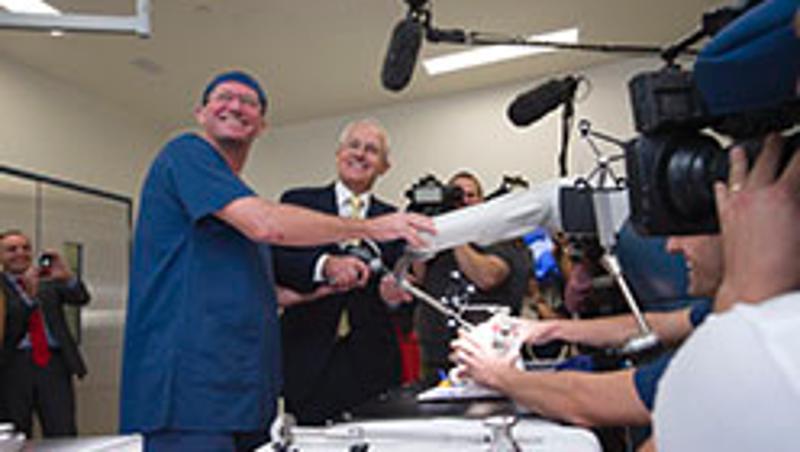
World leading medical innovation was on display when Prime Minister Malcolm Turnbull officially launched new technology in Brisbane today that allows surgeons to perform more accurate hip and knee replacements.
Orthopaedic surgeon and QUT Professor Ross Crawford, who recently led Australia's first robotically assisted hip replacement operation, demonstrated the revolutionary system from US-based medical technology company Stryker to the Prime Minister, and the nation's media at Brisbane's Holy Spirit Northside Hospital.
Robot technology for hip operations has been used for some years in the United States, but until recently had not been used for a hip replacement operation in Australia.
And with more than 43,000 total hip replacements carried out in this country last year alone, it's exciting news.
Experts now predit that robot-assisted hip replacements will soon become just as popular as robot-assisted knee operations, which started in Australia only last year. (More than 280 of these partial knee replacements have been performed in 12 months.)
Professor Crawford and his QUT colleages Anjali Jaiprakash (Post-Doctoral Research Fellow, Medical Robotics) and Professor in Robotics Jonathan Roberts have provided a detailed analysis of what's involved in a robotically assisted hip replacement operation - and why robots can benefit patients and surgeons:
"A hip replacement involves an incision to expose the hip joint and the placement of an acetabular component (the cup) and a femoral component (the stem). A head is then placed on the stem and a ball and socket joint is created that is the patient’s new hip," they said.
"Though very successful, the operation can be quite challenging to perform in certain patients such as the very overweight and those with complex deformities due to childhood diseases or trauma. There is also a learning process for the surgeon in performing a hip replacement and it is hoped this can be shortened by using robotic technology.
"Accurate positioning of the components of a hip replacement is important. Having the cup and stem in the correct position can decrease the chance of complications such as dislocation, where the head comes out of the cup. Making sure the joint stem is located in a way to ensure optimal leg length may also lead to improved function of the new hip.
"Accurate positioning of the components of a hip replacement is important. Having the cup and stem in the correct position can decrease the chance of complications such as dislocation, where the head comes out of the cup. Making sure the joint stem is located in a way to ensure optimal leg length may also lead to improved function of the new hip.
"Currently, surgeons rely on their experience and judgement to correctly place the components of a hip replacement. Many studies have shown that even experienced surgeons can have difficulty in reliably and accurately placing the cup in the correct orientation. They sometimes find placement of the stem challenging too.
"This is where a robot can help.
"The Stryker-owned MAKO robotic system launched by the Prime Minister today is a carefully controlled robotic arm that aids surgeons in placement of the components of a total hip replacement.
"It makes the operation more accurate and safer for surgeons, regardless of their experience.
"Though the robot is constraining the surgeon to execute the plan, the surgeon remains in charge at all times. The surgeon continues to carry all responsibility for the success of the operation and any complications.
"This first step of robotically assisted total hip replacement is relatively easy. The robotic technology (robotics, navigation and haptics) being used is very mature.
"But, as we are seeing in many industries, the capability of robotics is expanding rapidly. It will not be long before the technology is advanced enough to take over far more of the operation from the human surgeon.
"Then the big ethical questions will arise. Even now orthopaedic robots are being limited in what they can do because the step to autonomous surgery is currently a step too far.
"Like driverless cars, the questions of liability and trust continue to be aired when discussing robotic-surgery or health care.
"But also like driverless cars, robotic surgeons do not have to be perfect. They just have to be better than humans."
Further information: media@qut.edu.au




